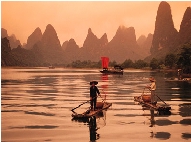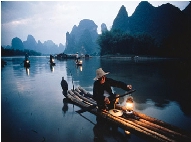|
 Located
in the northeastern part
of Guangxi Zhuang
Autonomous Region,
between latitude 248 and
251 north and longitude
1095 and 1100east, it
covers an area of 4195
square kilometers and
has a population of 1.2
million. Guilin Located
in a temperature zone of
subtropical climate, an
average temperature is
20 with an annual
rainfall of 1890 mm. Located
in the northeastern part
of Guangxi Zhuang
Autonomous Region,
between latitude 248 and
251 north and longitude
1095 and 1100east, it
covers an area of 4195
square kilometers and
has a population of 1.2
million. Guilin Located
in a temperature zone of
subtropical climate, an
average temperature is
20 with an annual
rainfall of 1890 mm.
Guilin is a historical
and cultural city as
well as a tourist
wonderland of world
fame. It literally means
"cassia tree forest",
named for the local
cassia trees, whose
scent wafts through the
city in autumn.
"Guilin boasts the most
beautiful scenery under
Heaven" is a saying
popular among its
admirers. There are
green hills and fields,
forests of peculiar
pinnacles and the
beautiful Li River
winding through the
city. From Guilin to
Yangshuo, the river
travels 83 kilometers
with both shores
decorated with "numerous
green hills popped up
out of the ground," a
poetic and picturesque
environment in which one
cannot but feel relaxed
and re freshed. freshed.
The history of Guilin
dates back to over 2,000
years ago. It became a
town of strategic
importance in south
China when the first
Emperor of the Qin
Dynasty ordered digging
a canal to link the
Xiang River (which flows
into the Yangtze River)
and the Tan River (which
flows into the Pearl
River), thus connecting
two of China’s major
waterways. Over the last
few thousand years,
generations of literary
writers and poets have
chanted out numerous
pieces of verse and
prose in its praise,
many of which have been
passed down to the
present day thanks to
various carvings and
inscriptions on
precipices. The
picturesque city is
graced with humanistic
flavor by ruins of
prehistoric cultures of
about 40 to 50 thousand
years ago, stone tombs
of the Ming Dynasty,
inscriptions and
sculptures on rocks
scattered around in
every corner of the
city, and by an ancient
town kept intact. Guilin
is a typical karst
landform area. Several
hundred million years
ago, it was a sea here,
under which there were
accumulated limestone
layers a few thousand
metres thick. In the
movement of the earth’s
crust, rocks deep down
below the sea surged up
and the sea gave way to
the land. Then, about
another 70 million years
had passed before the
landscape of Guilin
developed, with the help
of the natural elements
of wind and rain, into a
wonderland of weird
shaped and isolated
peaks and bizarre and
fantastic-looking caves
amidst limpid waters and
nice fields.
Guilin is also a
multi-national city with
a population of 1.25
million of 11 ethnic
groups of the Han,
Zhuang, Miao, Yao, etc.
The diversity in dresses
and social customs of
different ethnic groups
offers colorful folklife
and attracts large
numbers of tourists from
home and abroad.
Guilin, now a world
famous tourist city,
attracts large numbers
of tourists from the
world over. The
increasing number of
tourists has promoted
the rapid development of
tourist facilities.
Today, there are over 20
air routes connecting
Guilin with Hong Kong
and major domestic
tourist cities.
Guilin is a clean city
with charming waterfront
and ever-changing moods.
Hills and parks mottle
the urban landscape. A
few sights, like
Elephant Trunk Hill,
Wave-Subduing (Fubo)
Hill, and the port area,
are illuminated at
night. And the many
small restaurants offer
particularly Li River
cuisine, such as fish,
eel, frog, snail, shrimp
and snake.
In addition to the
landscape tour in
Guilin, tourists today
are offered added
attractions in the
neighboring areas,
including a virgin
forest in Longsheng, the
Ancient Ling Canal in
Xing’an and floating on
Li River, etc. |